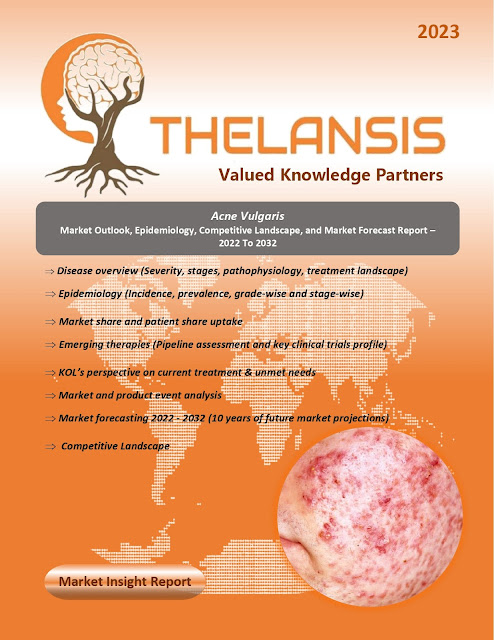Pyoderma Gangrenosum (PG) – Market Outlook, Epidemiology, Competitive Landscape, and Market Forecast Report – 2023 To 2033
Pyoderma gangrenosum (PG) is a rare skin disease characterized by the formation of ulcers on the body, particularly in the pre-tibial area, which often results in unsightly scar tissue. Diagnosis of PG relies primarily on clinical observation since no specific markers are detectable through blood tests or tissue analysis. The underlying causes and mechanisms of PG are not well understood, and current treatments are based on empirical evidence rather than targeted approaches. PG is characterized by recurring painful ulcers on the skin, most commonly found on the pre-tibial region but can appear anywhere on the body, including the trunk, head and neck, upper limbs, and genitalia. Multiple ulcers can co-occur on different anatomical sites, and PG may also manifest in the peristomal area, accounting for a significant proportion of chronic parastomal ulcers. About 50% of PG cases are associated with systemic diseases, while the remaining cases are idiopathic. Inflammatory bowel disease, rheumatoid arthritis, and hematological malignancies are the most commonly linked diseases. There are four distinct classes of PG: ulcerative, pustular, bullous, and vegetative. These classifications aid in recognizing different disease presentations, although variants can overlap. Ulcerative PG, or classic PG, is the most common form, exhibiting the previously described symptoms, and is frequently associated with inflammatory bowel disease, arthritis, or monoclonal gammopathies. Pustular PG is a more superficial variant primarily linked to inflammatory bowel disease. Bullous PG is another superficial form characterized by painful blisters, predominantly on the upper limbs and face, often associated with hematological malignancies. Vegetative PG is usually less aggressive than other variants, progressing slowly with fewer symptoms and generally responding well to milder treatments. Peristomal PG may develop after ileostomy or colostomy in individuals with inflammatory bowel disease, possibly due to the surgical procedure or subsequent irritation by the stoma apparatus or fecal leakage. Currently, there is no specific or targeted therapy for PG, and treatment approaches rely heavily on empirical evidence, considering factors such as the severity and extent of ulceration, associated diseases, and patient characteristics. The primary goals of treatment are to reduce inflammation and pain in the lesions and promote healing.
·
The prevalence of PG, standardized for age and
sex, is 5.8 cases per 100,000 adults. Adjusted prevalence rates indicate a
nearly two-fold higher occurrence in women (7.1 cases per 100,000) compared to
men (4.4 cases per 100,000).
·
The highest standardized prevalence is
observed in individuals aged 70 to 79 (9.8 cases per 100,000), with patients
aged 50 or older accounting for nearly 70% of all PG cases.
Thelansis’s
“Pyoderma Gangrenosum (PG) Market Outlook, Epidemiology, Competitive Landscape,
and Market Forecast Report – 2023 To 2033" covers disease overview,
epidemiology, drug utilization, prescription share analysis, competitive
landscape, clinical practice, regulatory landscape, patient share, market
uptake, market forecast, and key market insights under the potential Pyoderma
Gangrenosum (PG) treatment modalities options for eight major markets (USA,
Germany, France, Italy, Spain, UK, Japan, and China).
KOLs insights of Pyoderma Gangrenosum
(PG) across 8 MM market from the centre of Excellence/ Public/ Private
hospitals participated in the study. Insights around current treatment
landscape, epidemiology, clinical characteristics, future treatment paradigm,
and Unmet needs.
Pyoderma
Gangrenosum (PG) Market Forecast Patient Based Forecast Model (MS.
Excel Based Automated Dashboard), which Data Inputs with sourcing, Market
Event, and Product Event, Country specific Forecast Model, Market uptake and
patient share uptake, Attribute Analysis, Analog Analysis, Disease burden, and
pricing scenario, Summary, and Insights.
Thelansis Competitive Intelligence (CI) practice
has been established based on a deep understanding of the pharma/biotech
business environment to provide an optimized support system to all levels of
the decision-making process. It enables business leaders in forward-thinking
and proactive decision-making. Thelansis supports scientific and commercial
teams in seamless CI support by creating an AI/ ML-based technology-driven
platform that manages the data flow from primary and secondary sources.
Tags: Pyoderma
Gangrenosum (PG), Pyoderma Gangrenosum (PG) market
outlook, Pyoderma Gangrenosum (PG) competitive
landscape, Pyoderma Gangrenosum (PG) market
forecast, Thelansis, Primary market research, KOL insights, Competitive
Intelligence (CI)



%20Market%20Outlook%20and%20Forecast.webp)
Comments
Post a Comment